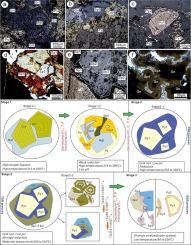Ore Geology Reviews ( IF 3.2 ) Pub Date : 2022-08-11 , DOI: 10.1016/j.oregeorev.2022.105063 Jinhua Qin , Fan Huang , Shihua Zhong , Denghong Wang , Reimar Seltmann

|
The Shuikoushan ore field is one of the largest Pb-Zn-Au polymetallic magmatic hydrothermal system in South China and hosts a significant metallogenic potential. In this study, detailed garnet U-Pb dating, sulfide trace element and sulfur isotopic analyses were conducted to reveal the features during ore formation. Chronologically, garnet U–Pb dating yields ore-forming ages of 158.8 ± 1.4 Ma for the Yagongtang deposit, 158.8 ± 2.5 Ma for the Kangjiawan deposit and 154 ± 18 Ma for the Laoyachao deposit, respectively. The ore formation history in the Shuikoushan ore field can be subdivided into four stages, and five types of sphalerite (Sp0 to Sp4), and three types of pyrite (Py to Py2) from early to late are identified. The distinct compostions indicate that sphalerite and pyrite were formed by different trace/minor element substitution mechanisms and oxidation state, although sulfur isotopes indicate a consistent sulfur origin. Combined with previously published studies, this work demonstrates that the Shuikoushan ore field belongs to a prolonged hydrothermal system. Its mineralization was genetically correlated with the emplacement of granodiorite, and the thermochemical sulfate reduction (TSR) process (Stage 2) and bacterial sulfate reduction (BSR) process (Stage 3) dominated the evolution of sulfur and facilitated the participation of sulfides within the Shuikoushan ore field.
中文翻译:

通过石榴石 U-Pb 测年、硫化物微量元素和同位素分析揭示大型热液系统的演化历史:以华南水口山多金属矿田为例
水口山矿田是华南地区最大的铅锌金多金属岩浆热液系统之一,具有显着的成矿潜力。在这项研究中,进行了详细的石榴石 U-Pb 测年、硫化物微量元素和硫同位素分析,以揭示成矿过程中的特征。从年代学上看,雅公塘矿床石榴石U-Pb测年的成矿年龄为158.8±1.4 Ma,康家湾矿床为158.8±2.5 Ma,老鸭巢矿床为154±18 Ma。水口山矿田的成矿历史可细分为4个阶段,识别出早晚5种闪锌矿(Sp0~Sp4)和3种黄铁矿(Py~Py2)。不同的成分表明闪锌矿和黄铁矿是由不同的痕量/微量元素替代机制和氧化态形成的,尽管硫同位素表明硫的来源是一致的。结合此前发表的研究,本工作表明水口山矿田属于一个长期的热液系统。其矿化与花岗闪长岩的就位在成因上相关,热化学硫酸盐还原(TSR)过程(第 2 阶段)和细菌硫酸盐还原(BSR)过程(第 3 阶段)主导硫的演化,促进了水口山内硫化物的参与矿场。此项工作表明水口山矿田属于长期热液系统。其矿化与花岗闪长岩的就位在成因上相关,热化学硫酸盐还原(TSR)过程(第 2 阶段)和细菌硫酸盐还原(BSR)过程(第 3 阶段)主导硫的演化,促进了水口山内硫化物的参与矿场。此项工作表明水口山矿田属于长期热液系统。其矿化与花岗闪长岩的就位在成因上相关,热化学硫酸盐还原(TSR)过程(第 2 阶段)和细菌硫酸盐还原(BSR)过程(第 3 阶段)主导硫的演化,促进了水口山内硫化物的参与矿场。











































 京公网安备 11010802027423号
京公网安备 11010802027423号